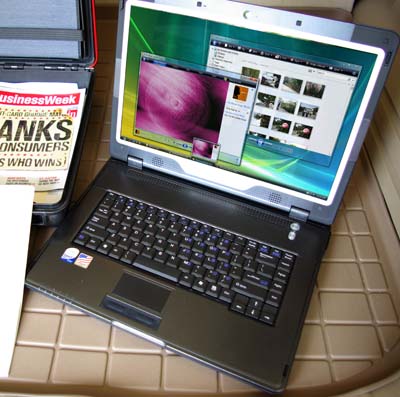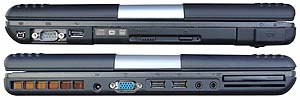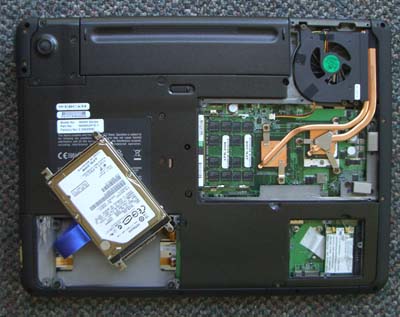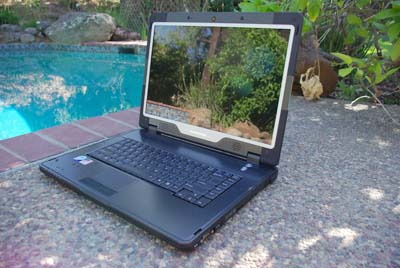Founded in 2002, Averatec initially concentrated on offering stylish notebook computers at low prices and has recently branched out into new form factor desktops, ultra-mobile PCs, GPS devices and other handheld electronics. In April of 2008, Averatec, which is currently going through a name change to Trigem, announced its entry into the semi-rugged notebook market with the Voya series.

The Averatec Voya 6400 is a fairly compact semi-rugged notebook that weighs a reasonable 6.4 pounds and comes with a 15.4-inch wide-format display. Base RAM is 2GB of DDR2 RAM, expandable to 4GB. There is a 250GB Serial ATA hard disk and a SuperMulti dual layer DVD burner that opens toward the right. For video conferencing, the machine has an integrated 1.3 megapixel vidcam.
The keyboard is, of course, full-size and has 88 keys. Keys are black with very legible white labels. A blue-labeled function key is used in conjunction with other keys for brightness and volume control, numeric keypad, sleep, 3G radio activation, Bluetooth activation and a few more functions.
Cursor control is via a fairly small touchpad with a vertical cursor scroll area to the right and rubberized left and right mouse keys below.
The handsomely designed 6400 Series has a magnesium alloy outer case, a spill-resistant keyboard and touchpad, and a shock-mounted hard drive.
Good performer
For processing, the Voya has a beefy 2.2GHz Intel Core 2 Duo T7500. This is a high performance mobile processor with an 800MHz frontside bus and 4MB of L2 cache. Its thermal design power is 35 watts, way higher than that of ultra low voltage mobile processors that usually have a TDP in the single digits. This clearly means Averatec seeks to provide speed more so than long battery life.
To find out how fast the Voya 6400 is we installed Passmark Software's PerformanceTest 6.1 that runs about 30 tests covering CPU, 2D graphics, 3D graphics, memory, and disk and then computes scores for each category and an overall PassMark score. For comparison we listed the approximate performance range of 1.2 GHz Core Duo U2500 machines. The U2500 has been a popular choice in tablets and other highly portable mobile systems. The results are as follows:
|
PERFORMANCE
|
Voya (2.2GHz T7500)
|
Typical 1.2GHz U2500
|
|
CPU Mark
|
1264
|
610-640
|
|
2D Graphics Mark
|
305
|
150-170
|
|
Memory Mark
|
523
|
200-240
|
|
Disk Mark
|
266
|
200-320
|
|
3D Graphics Mark
|
102
|
90-100
|
|
Overall PassMark
|
543
|
280-320
|
As you can see, the T7500-equipped Voya is a much faster machine than your typical U2500-powered mobile device. This is especially evident in CPU, 2D graphics and memory operations, and less so in disk and 3D graphic performance where subsystems determine performance rather than the processor alone.
Connectivity
The front of the Voya 6400 features a SIM card compartment as well as a 4-in-1 Media Card reader that can handle Sony Memory Stick, Sony Memory Stick PRO, MultiMedia Cards and SD Cards.
The back of the unit does not have any ports or anything else other than a Kensington lock slot for hardware security.

On the left side of the computer are two USB ports, audio in and out jacks, a 15-pin video-out jack, an Express Card slot and a SmartCard slot. You can also see six vent holes to the large heat exchanger inside.
 On the right side is a IEEE1394 "Firewire" port, a third USB port, a 9-pin serial port, an RJ11 modem and a RJ45 LAN jack, and the SuperMulti Dual Layer DVD burner. The modem and LAN jacks site next to one another and the computer comes with a non-attached rubber plug to seal them.
On the right side is a IEEE1394 "Firewire" port, a third USB port, a 9-pin serial port, an RJ11 modem and a RJ45 LAN jack, and the SuperMulti Dual Layer DVD burner. The modem and LAN jacks site next to one another and the computer comes with a non-attached rubber plug to seal them.
Expansion and access
The bottom of the Voya has several metal doors held in place with Philips screws.
A small one (see bottom right) covers a wireless modules area with two PCIe Mini Card connectors. In our unit, one was taken up with an Intel PRO/Wireless 3945ABG module, the other was free to accommodate an additional WAN or other module. The door is not meant to seal the opening as there is no rubber seal and the cover contains ventholes.

Another cover (see bottom left), also unsealed, protects the hard disk which in our tester was a 2.5-inch 5400rpm 250GB Hitachi 1.5GB/second SATA drive. The disk is sitting in a metal subframe that is then rubber-mounted onto the chassis of the Voya.
The largest cover provids full access to the Voya's processors, fan, and two memory slots. The memory slots in our machine were populated with 1GB PC2-5300 CL5 modules. Note the copper heat conduits that move heat from the processor to the fan.
The 48 watt-hour Lithium-Ion battery glides into the rear of the computer and then locks. It is relatively modest for a computer this size. As long as the computer is plugged in, it can be replaced without shutting the system down.
Webcam
Our Voya came with the optional webcam. It is a 1.3 megapixel device that you can use for video conferencing The Voya has an AMCap utility that works with the GenesysLogic USB 2.0 camera and can be used to take individual pictures or video capture. Image and video quality are quite good.
Display
Semi-rugged notebooks are often used outdoors and so a certain degree of outdoor and sunlight readability is expected. Averatec does not claim sunlight readability nor any optical/anti-reflective coatings. Surprisingly, the big 15.4-inch wide-format does quite well outdoors. It cannot match specialized sunlight-readable displays, but it does not wash out completely either. In fact, you can read text in direct sunlight. Unfortunately, like most notebooks these days, the Voya has a glossy display surface, and so the main problem outdoors is glare and reflection.
Ruggedness
Averatec introduced the Voya machines as "semi-rugged" notebooks. There is no official definition of what semi-rugged means, so let me explain what the Averatec Voya 6400 offers.
On its website, Averatec describes the 6400 Series as offering "military grade reliability against accidental bumps and bruises while you are traveling" and states that "even the occasional spill is covered as [the Voya] features a spill resistant keyboard and touchpad."
There are no elaborations what "military grade reliability" means in this machine. Usually, any mention of military grade testing is accompanied with results obtained from running a machine through a series of tests in accordance with the procedures described in MIL-DTS-810F.
Absent that, we assume the Voya was designed to withstand the kinds of accidents it might encounter in an office and while on travel. Trivial though it may sound, one of the major causes of damage/failure is when coffee or soda is accidentally spilled onto the keyboard.
The magnesium top and bottom case is very sturdy, and there is anti-shock mounting that protects the LCD and the hard disk. The four corners of the bottom as well as the top case of the computer have rubberized bumpers that stick out just enough to provide extra protection and keep the metallic case from getting scratched. When you close the Voya two snaps engage to keep the LCD part securely fastened to the bottom part. Should the computer fall, the LCD cannot twist and get damaged.
As far as drops go, since the Voya stems from the Twinhead Durabook family, we may assume that the Voya passes the same drop tests as are claimed for all Durabooks. That would be a total of 26 drops in non-operating mode from a height of 29 inches. Vibration resistance appears measured by MIL-STD-810F, Method 514.5, Procedure I, which simulates 1,000 miles of truck transportation.
For sealing, the documentation stresses the spillproof keyboard and keypad. Durabook laboratory tests suggest conformance with European Committee for Electro Technical Standardization IP31.
What all this means is that the Voya is a rather tough, well-constructed machine that includes a good deal of shock-absorption. It will probably survive drops from office desks and airplane seats and the occasional spill.

Bottom line
The Averatec Voya 6400 is a very appealing machine with good performance and a large, easily readable display. Pricing starts at US$1,599, a fair price for a notebook that has a 1280 x 800 pixel wide-format display, a good deal more power than Averatec's basic 4400 Series and provides some extra protection against bumps, spills and bruises. The addition of a Smart Card reader and a SIM card slot offer security and communication options not universally available.
We would not see this machine as a direct competitor to the rugged offerings by Panasonic, GD-Itronix or Getac. Rather, it is an economically priced, tougher alternative to consumer notebooks from Dell, HP and others, as well as the business-class machines from Panasonic.



